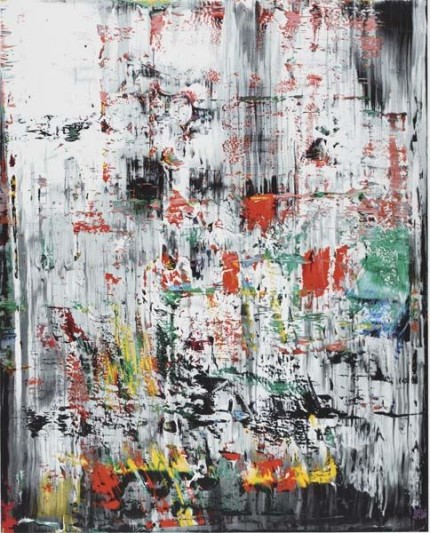ICE’s edgy Art Institute concert reflects its canvas inspiration

A largely youthful capacity audience at the Art Institute’s Fullerton Hall was treated to a muscular dose of envelope-pushing music in a postmodern context Friday evening by flutist Claire Chase and pianist Jacob Greenberg. Chase is the founder and director of ICE (International Contemporary Ensemble) and Greenberg a longtime associate. Together and separately, these wonderfully matched performers created a short program that managed to exceed the limited potential for flute and piano collaboration.
The program was one in a series of Art Institute-sponsored Concerts with Commentaries, relating music and specially chosen art works. As outlined in Whit Bernard’s illuminating program note, the work in question is, aptly, Gerhard Richter’s painting Eis 2 (“Ice 2”), which inspired this short program by its “hurried, aggravated abstraction and its layered density.”
The stylistically eclectic selections ranged from Salvatore Sciarrino’s amazing 1993 solo flute transcription of the iconic organ Toccata and Fugue in D minor by Bach to the groundbreaking 1946 Sonatine by the young radical Pierre Boulez as well as a solid performance of the moving Thoreau section of Charles Ives’ Concord Sonata for piano.
Using all the resources of the flute’s dynamics and registrations, Sciarrino’s retooled Bach for solo flute is a miniature triumph of transcription and proved the biggest crowd-pleaser. Chase’s technical expertise handled the abundance of challenges and tricks that managed to replicate the huge multi-voiced demands of this large-scale warhorse.
Also substantial was Fili (1981) by Franco Donatoni, a powerful work requiring great accordance between the performers in a passive-aggressive sequence of patterns and spaces. The description of the piece by an elementary school participant in a recent ICE Outreach program hit the mark: “angry pretty butterflies.”
The Thoreau section of Ives’ epic Concord Sonata, which cuts so close to the heart of this composer, was given a strangely abstract performance. While displaying great technical virtuosity, Greenberg‘s approach was mostly straightforward, the music coming to life only with the entry of Thoreau’s instrument, the flute, from the upper reaches of the small amphitheater. The work concluded in an atmospheric and bell-punctuated silence.
Augusta Read Thomas’ Euterpe’s Caprice (2008), written for the performers and with the composer present was short and characteristically dense, passing by in the blink of an eye.
The other significant work on the program was the Boulez Sonatine for flute and piano, written in 1946, and one of the earliest efforts the composer still acknowledges. In fact this work bears frequent rehearing, especially from the hands of such committed performers. It has survived in the repertoire as a fully mature expression of the composer’s carefully constructed and exquisite style with many of the technical elements of his later works already in place. Characteristically percussive elements alternate with delicate filigree as when the flute hovers above extended piano trills in a beautiful inner section. The whole piece has a forward impetus that is quite exhilarating and comes to rest quite naturally in a florid explosion of trills and upper register squeals sounding like nothing less than a miniature cadenza.
Claire Chase ended the short but demanding program with a fluent encore of the Adagio from Bach’s Flute Sonata in E Flat Major, BWV 1031, which sent the audience out into the Buddha Galleries in a properly soothed and reflective state of mind.
Posted in Uncategorized


